The operation concluded on July 25, 2023. 1,107 wild horses were captured and there were 10 deaths.
July 25, 2023: AWHC staff members Tracy Wilson, Nicole Hayes, and Steve Paige arrived at the meet-up point at 8:30 am and were at the observation place by 9:20 am. When our observers arrived they saw cows in the wings which wranglers moved on horseback. They were told the helicopter was getting a part in the am and expected to be in the air by 9:30 but did not hear it until 11:03 at the first run.
There were four runs. The first started at 11:03, and was complete by 11:22. The second started at 11:40, and the horses were in the trap by 11:59. The third started at 12:24, and the horses were not in the trap until 12:50. For the fourth and final run, our observers could hear helicopter at 1:30 but couldn't see them. They finally saw them at 1:39, and the operation was completed at 1:49.
During the third run, there was a large group of horses who came down behind the trap, but they turned and ran all the way across the valley to the tree line rather than into the trap. The pilot was able to bring 6 back but the others were lost to the trees. The stallion in this group gave the pilot a run and would not turn back to the trap, he turned on the speed and got across the valley to the trees.
During the final run, a foal & yearling fell behind. The band returned, and the pilot waited for them to rejoin then pushed them all together. The young foal remained in the middle of the band from that point on.
For the entirety of the runs, our observers were placed too far away to see if the horses were sweaty. Our observers arrived at the temporary holding to see the newly captured animals. The horses had just been sorted, fed, and watered. The mares were agitated and our observers did not note any injuries.
July 24, 2023: The roundup was paused for equipment maintenance today.
July 23, 2023: Today 94 wild horses lost their freedom. AWHC’s observer was one of two members of the public. They had a good view of the horses approaching the trap wings, but the observation point offered no view of the actual trap site or loading.
The helicopter made about 10 runs. Our observer noted the last few runs occurred in high temperatures ranging from 97-99.
The observer also noted a young foal struggling to keep up during the helicopter chase. This young baby eventually got separated from their family. This baby was not much taller than the sagebrush surrounding it, so it’s easy to see how it could get lost.
After the rest of the baby’s family was caught, the contractors brought out a trailer and a few wranglers to catch the baby. We later learned that the mom and foal were reunited at temporary holding.
July 22, 2023: Approximately 14 wild horses were captured today. We had a distant view of the trap wings dropping out of sight. The actual trap site and loading were not visible from the observation area.
It was an early day, with the last flight ending before 9 AM.



July 21, 2023: 69 wild horses were captured and there were two deaths after a 20-year-old sorrel mare experienced "unexpected" lameness, and another foal was euthanized by BLM for having clubbed feet.
July 20, 2023: During the observation, the weather conditions were humid due to rain the previous night, with temperatures ranging from 58 to 94°F and winds at approximately 7mph. We met with the Bureau of Land Management (BLM) staff at Shelbourne Rest Area at 5:00 am and proceeded to the Spring Valley area. The helicopter arrived at the trap at 6:20 am.
1. First Run: A handsome Sorrell stallion veered off from the band and trotted by the observation point.
2. Second Run: A small foal was observed struggling to keep up with the band. The stallion encouraged the foal to run faster to stay with the group.
3. Dust Concerns: Dust at the trap area was a concern, and the water truck's activity was not observed.
4. Wrangler Intervention: A wrangler on horseback, accompanied by a second wrangler, roped the foal and brought it slowly into the trap. A veterinarian examined the foal and confirmed its well-being.
5. Horses' Behavior: The horses appeared more flighty and on edge, possibly due to being crowded into the catch pen. Their behavior caused chaos in the trap area, with horses pushing against panels, running into each other, and charging in the pens.
6. Stallion Incident: During the last run, a stallion attempted to clear the trap panel but got stuck, leaving him high-centered. After a brief struggle, the stallion managed to free himself and fled up the hill.
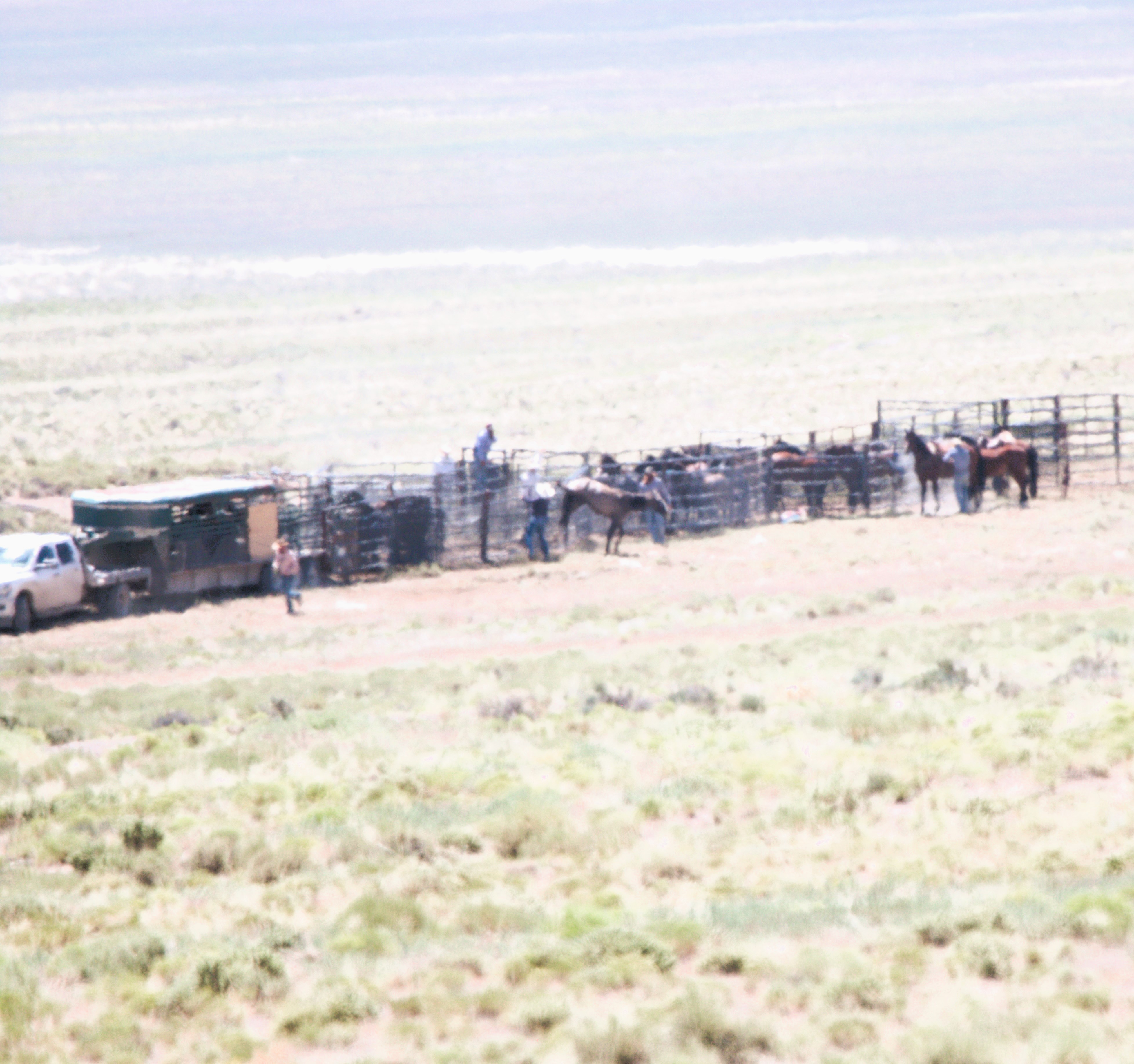

7. Heat and Visibility: With temperatures rising quickly, visibility became challenging due to the heat haze, making it difficult to observe clearly.
8. Conclusion: The roundup activities concluded around noon, with approximately 33 miles traveled to short-term holding. No injuries or deaths were reported during the observation.
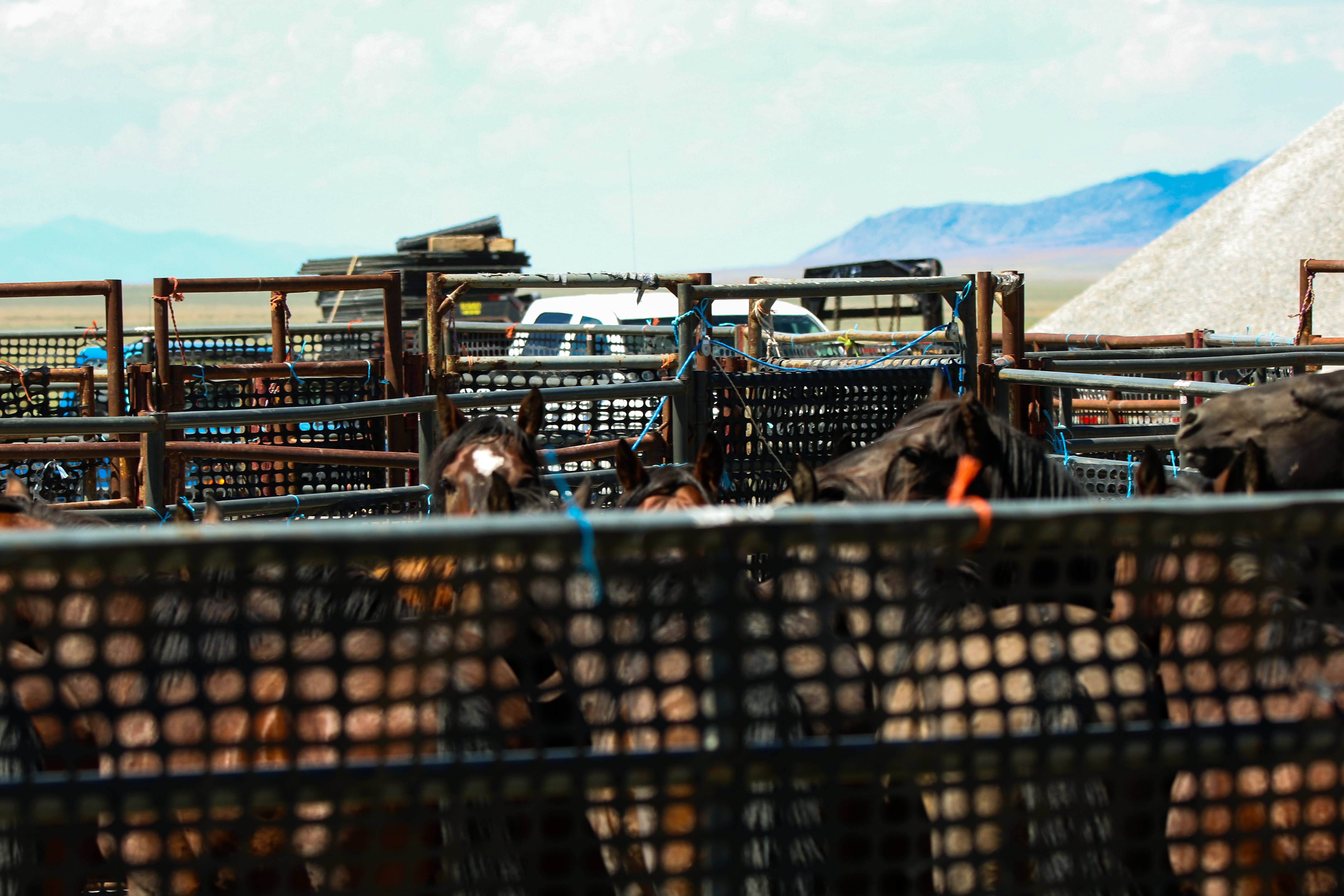

Roundup Statistics: As of July 19th, a total of 826 horses have been captured, including 259 stallions, 377 mares, and 190 foals. Out of these, 783 horses have been shipped to Palomino Valley Holding, comprising 243 stallions, 359 mares, and 181 foals. Seven deaths were reported, with one being pre-existing and six considered roundup-related.
28 Wild Horses Captured at Wednesday Operations
July 19, 2023
Observation Details:
- Meeting Time: The BLM staff met at 5:00 am at the Shelborne Rest Area, located approximately 43 miles north of Ely, NV
- Observation Location: The observation point was situated ¾ mile away from the horse trap.
- Weather Conditions: The weather was sunny with temperatures ranging from 55 to 85 degrees Fahrenheit. There was a slight wind of 5-10mph.
- Fly Zone: The fly zone was designated within an 8-mile radius from the observation point.
Observation Timeline:
- 6:21 am: A helicopter was spotted in the air, initiating the first run.
- 7:00-7:40 am: The second run took place, involving approximately five horses.
- 7:45 am: The helicopter returned to the air after refueling.
- 9:04 am: Around five horses were brought in, with one horse jumping the Jute and running down the wash. Another horse ran across the valley to the left.
- 9:09 am: The observation was concluded for the day.
- 10:17 am: The BLM staff arrived at the temporary holding area.


A load of horses was transported to the Palomino Valley Holding Center on the morning of the observation.
119 Horses Captured Today
July 18, 2023: I met with the Bureau of Land Management (BLM) staff at 5:00 am at the Shelborne rest area, located approximately 43 miles north of Ely, NV. The weather at that time was 68° F with drizzling rain. We then drove 28 miles to the new trap site area. The trap site was mostly visible, except for the entrance to the wings. Despite this limitation, I was able to maintain a decent proximity to view the activity.
The first run occurred at 6:45 am, followed by a second run at 6:55 am. During the second run, a stallion managed to evade the trap by running around it. He then stood there for a few minutes, watching the trap. After pacing back and forth, he eventually ran up the hill and disappeared behind the ridge. The stallion's family also appeared nervous, pacing back and forth, before eventually calming down enough to be loaded onto a trailer.
Later in the day, the stallion reappeared, loping between the observation area and the trap. It seemed that he was brought in on one of the later runs, as observed when visiting the holding area at the end of the day. At 12:23 pm, the temperature was 73° F with rain, but by 1:58 pm, the rain had stopped and the temperature rose to 86° F.
In total, there were 15 runs throughout the day. The trapping process appeared chaotic, with horses panicking and pushing against each other. Smaller horses sometimes got caught up while going through the gate. Two foals were roped, although one was not visible due to being behind a knoll. The visible foal was roped by the wrangler's horses and taken into the foal pen after a struggle with a young wrangler on foot. Each run seemed to cause panic among the horses.
At 2:57 pm, the trapping activities were concluded for the day. I visited the temporary holding area and did not observe any visible injuries. Families of horses that I had seen grazing happily together on the range a few days prior were now standing in the holding area.
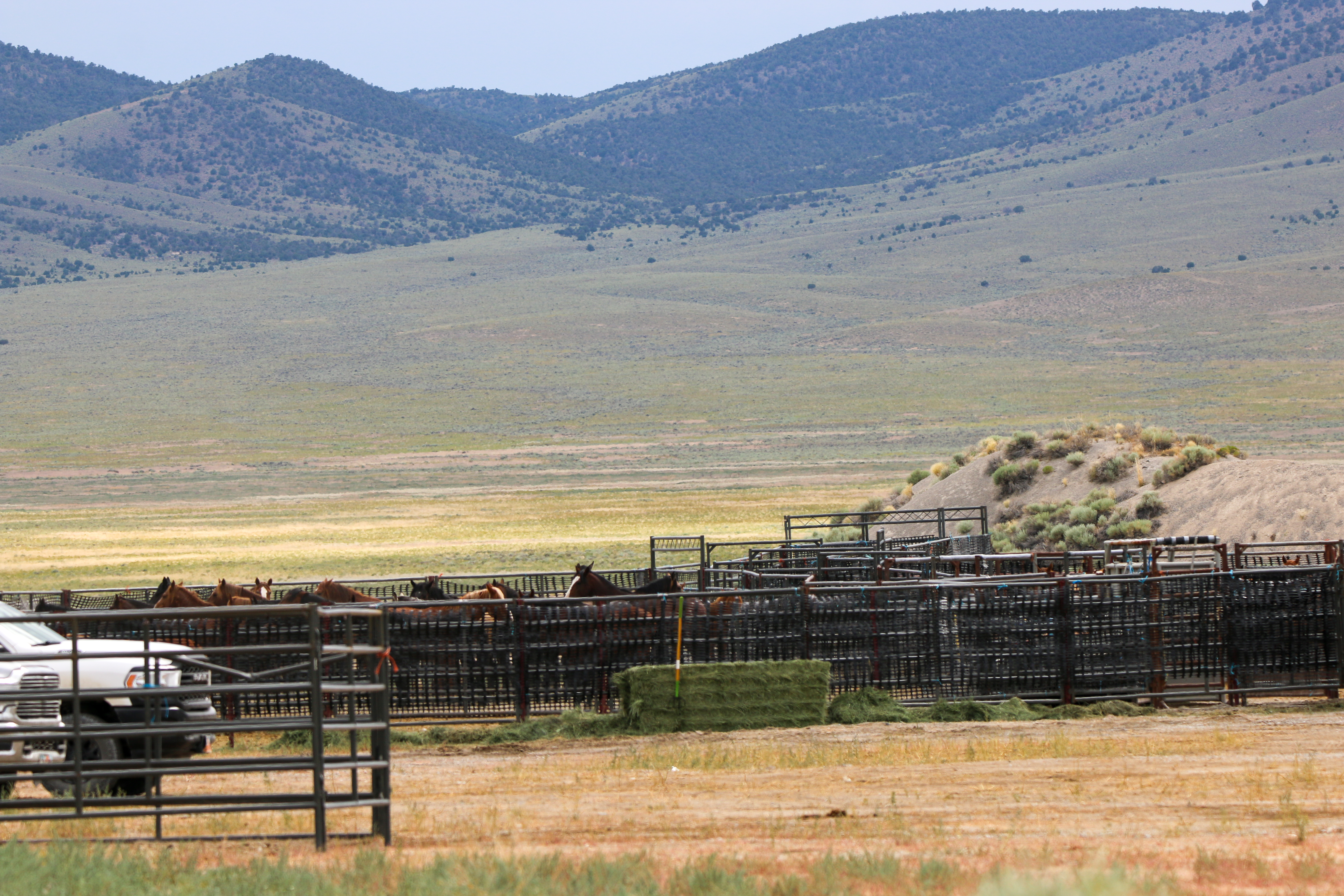
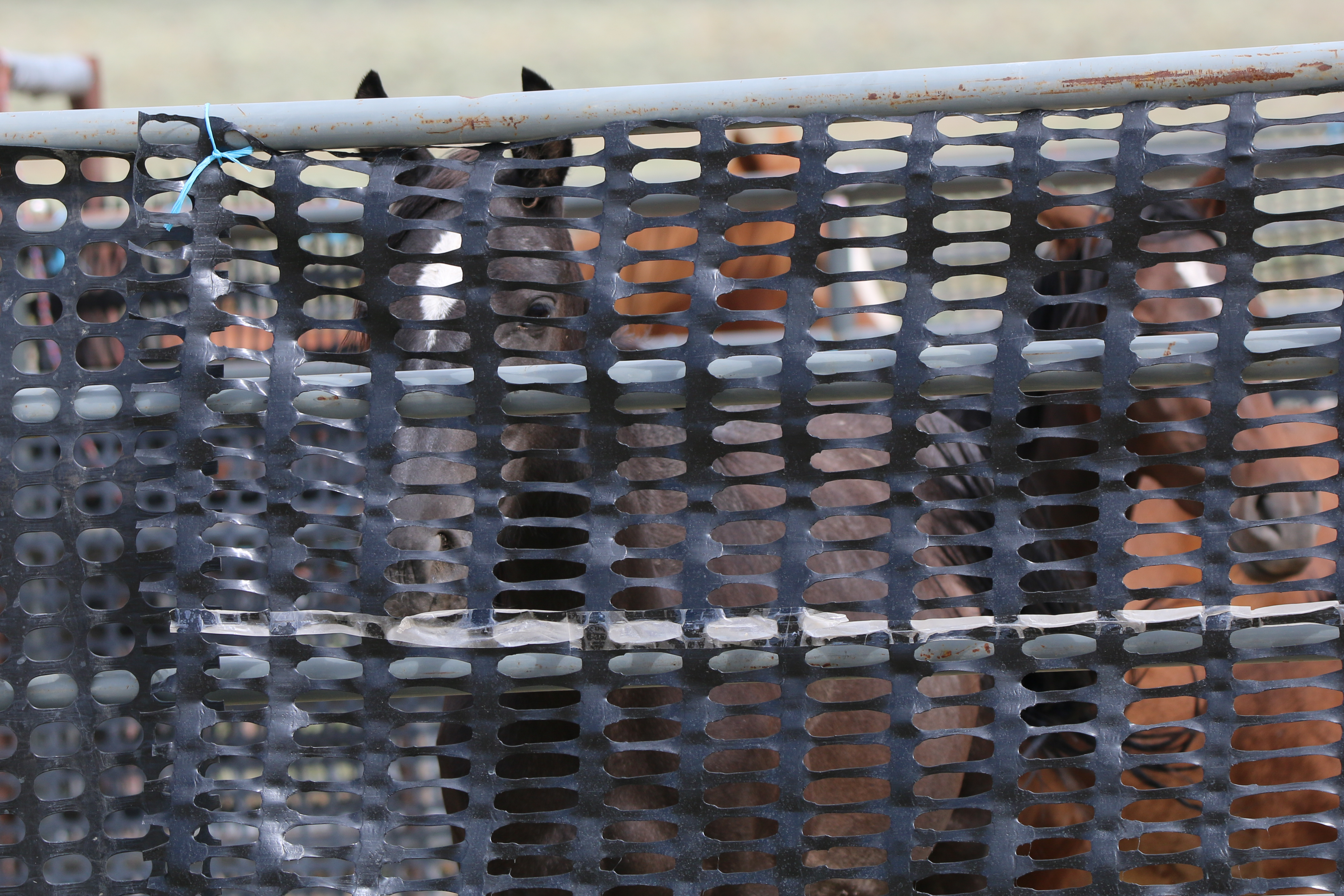
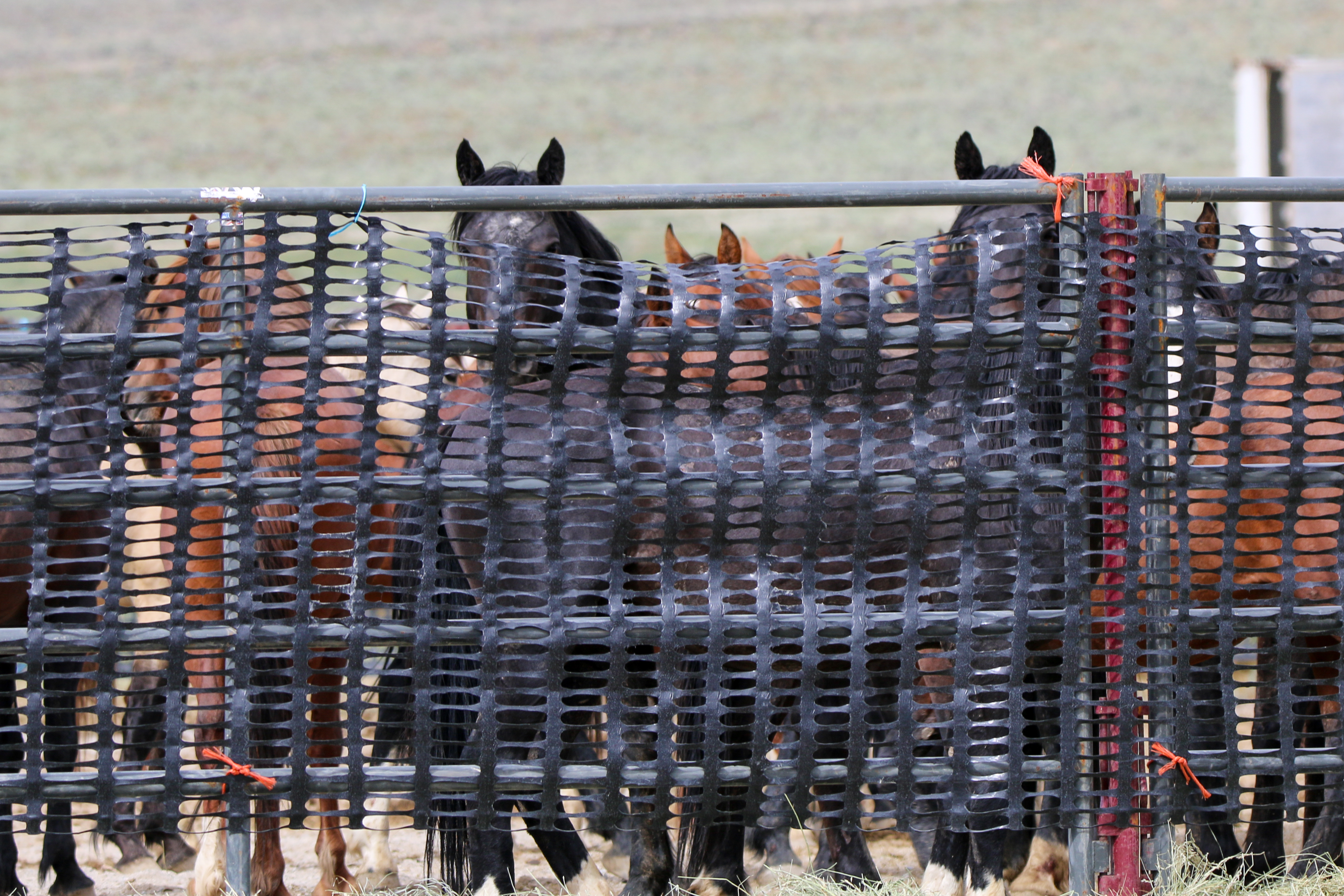
July 17, 2023: 12 wild horses were captured. The AWHC observer was not in the field today.
36 Horses Captured, Two Horses Break Necks at Sunday Operation
July 16, 2023: We arrived at the site at 5:45 am. We were assigned the same trap location as the previous day. The temperature at the meeting place was 61°, which was nine degrees higher than yesterday. As of now, we have not heard the sound of the helicopter yet. It is expected that we will experience record-breaking heat temperatures today. Over the past few days, I have noticed that the horses brought in appear tired, with sweat glistening on their backs. The foals seem to struggle to keep up with their family.
The first run took place at 7:00 am, followed by the second run around 8:15 am, and the third run at approximately 9:49 am. Unfortunately, I missed a band of horses eluding the helicopter due to the noise of a ranger truck idling nearby.
At 10:30 am, the next run occurred, during which I observed a small group of horses being pushed up the side of the ridge. They stopped and appeared tired.



The helicopter continued to push them toward the wing area, and at this point, the Palomino mare went down. I captured a sequence of photos showing her attempts to get up but failing. Shortly after, two livestock trucks were positioned in front of our view, blocking it for about ten minutes. There was a lot of commotion happening at the trap during this time.
At 10:50 am, one of the livestock trucks drove away, carrying the mare's foal. The other truck remained in front of the trap. They proceeded to load the mare into the trailer. It was a heartbreaking sight to see this angelic and magnificent mare standing on the crest before descending behind the hill and into the trap. This would be her first and last ride.
At 11:03 am, the temperature reached 97°, and we decided to conclude our observation for the day. On our way back to Ely, we encountered some of the mares participating in the 10-year Water Canyon wild horse growth suppression pilot program.
It was not seen nor reported until the time of this report, but a second mustang, a 3-year-old Roan stallion also suffered a broken neck after crashing into panels.
91 Horses Captured, Another Foal Dead in Antelope Complex Operation
July 15, 2023: I met BLM staff at 4:30 am at Shelbourne rest area, located 43 miles north of Ely. We then proceeded to the observation point in Antelope Valley, which was approximately 45 miles away from our initial meeting location.
Upon arriving at the observation point at 6:00 am, there were no runs yet as the contractors were still setting up at the trap area. We were placed in the same location as the previous day. At 6:08 am, the helicopter was heard in the air, and the first run began at 7:00 am, followed by the second run at 7:20 am, and the third run at 8:00 am. It was observed that the pilot would bring in a larger group and then split them into smaller groups to bring them into the trap. This method appeared to be a safer approach based on previous observations of other roundups.


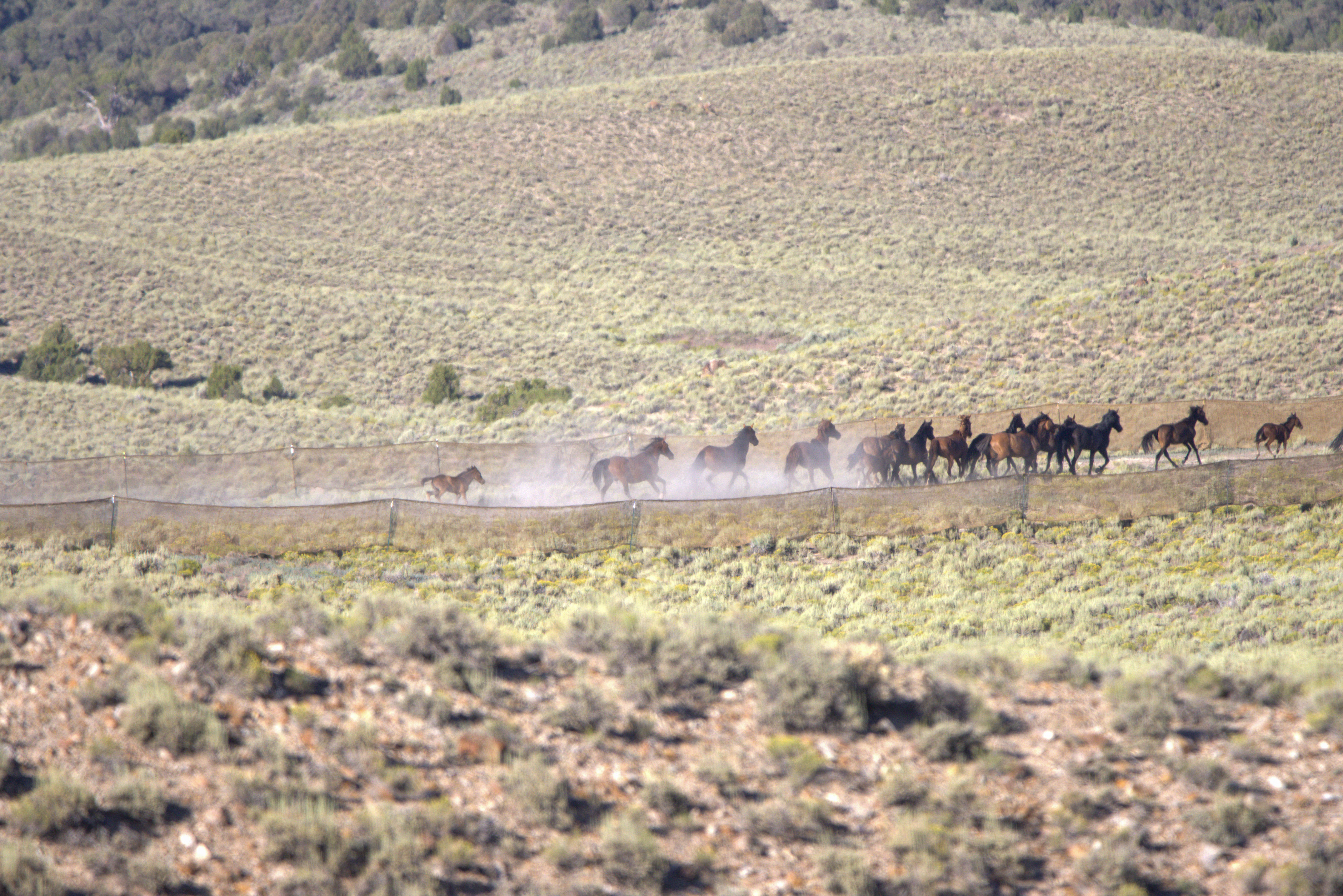
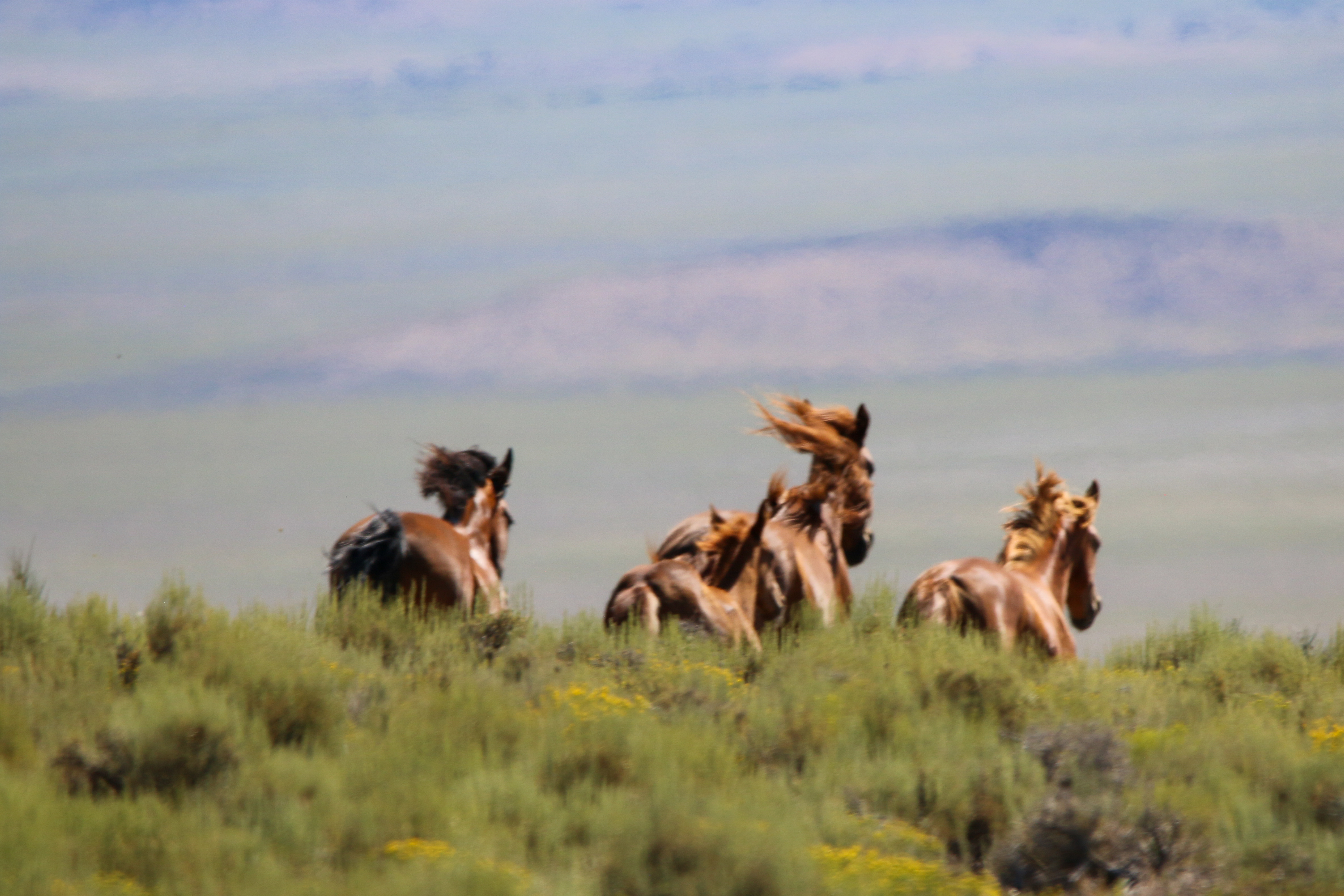
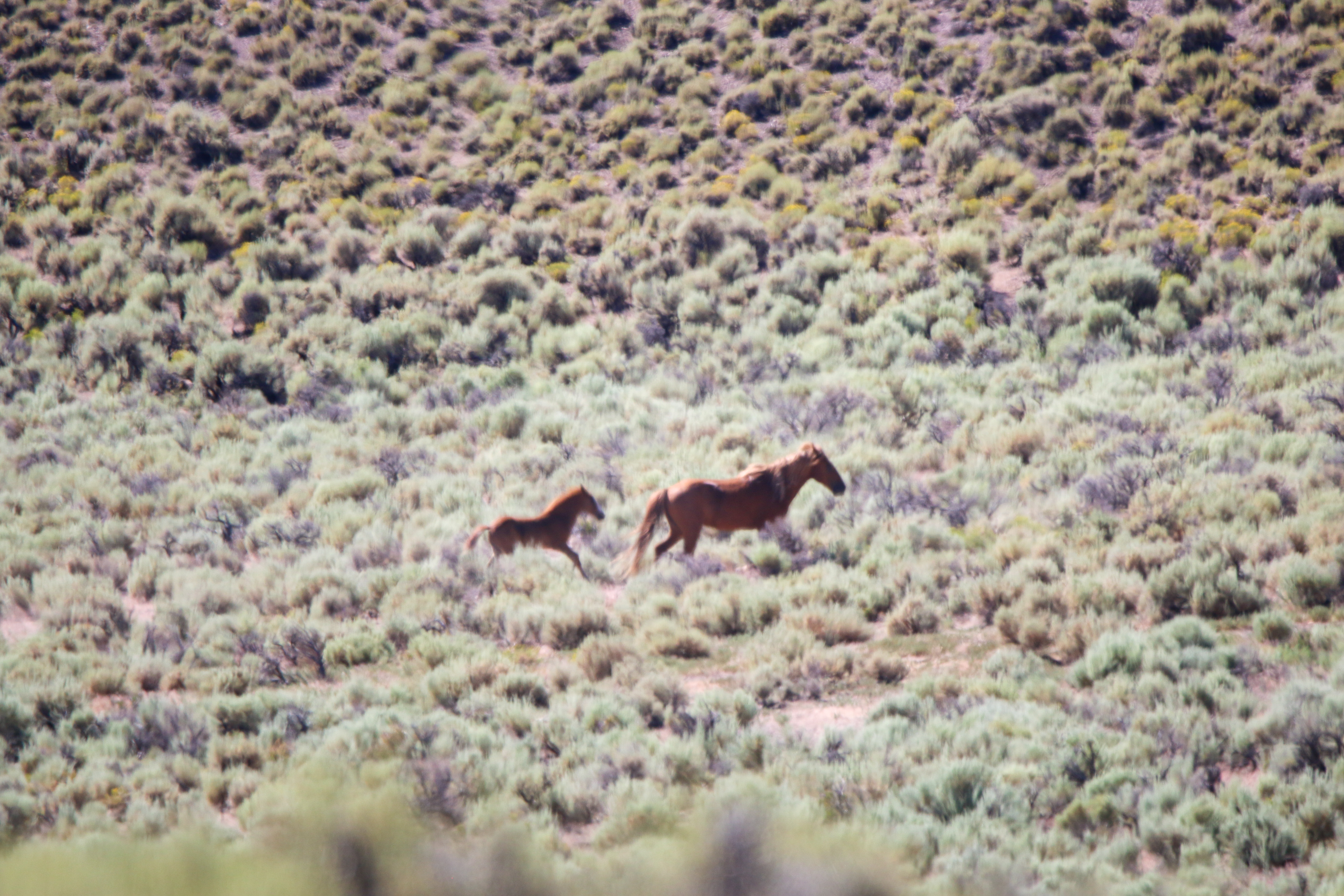
At 8:00 am, a foal was seen in the foal pen area, anxiously pacing back and forth while the older/larger mares and stallions were being loaded.
At 9:00 am, the helicopter refueled, and the fourth run commenced at 9:39 am, followed by the fifth run at 9:48 am.
Around 10:00 am, a veterinarian approached the trap area, although the reason for their visit was not specified.
At 11:31 am, another run came in from the other side of the trap, with the horses appearing tired and sweaty. During this run, a mustang attempted to jump the panel at the loading gate, but it was confirmed that he/she sustained no injuries. Due to the distance of the loading area, it was challenging to have a clear view of the events taking place.
At 12:25 pm, the observation was concluded for the day, with the temperature reaching 93°F. It is worth noting that the contractors' saddle horses were up to date on vaccinations, and some of the foals appeared to be off balance as they walked alongside the mares.
149 wild horses captured, 1 dead in Friday’s operation
July 14, 2023: On the first day at a new trap site, approximately 120 wild horses were captured. The Bureau of Land Management's (BLM) report was not updated at the time of this report.* One stallion died after hitting a panel at the back of the trap area.
The weather was sunny with temperatures ranging from 58 to 93 °F and wind speeds of 15-20 MPH.
The BLM staff met at 4:30 am at Shelbourne rest area and then proceeded to the Antelope Valley HMA. From a viewing area, the wings of the trap and the catch pen were visible, although the distance made it difficult to get clear shots due to the heat haze. The pilot made approximately 8-10 runs throughout the day, with the last run ending at 2:45 pm.
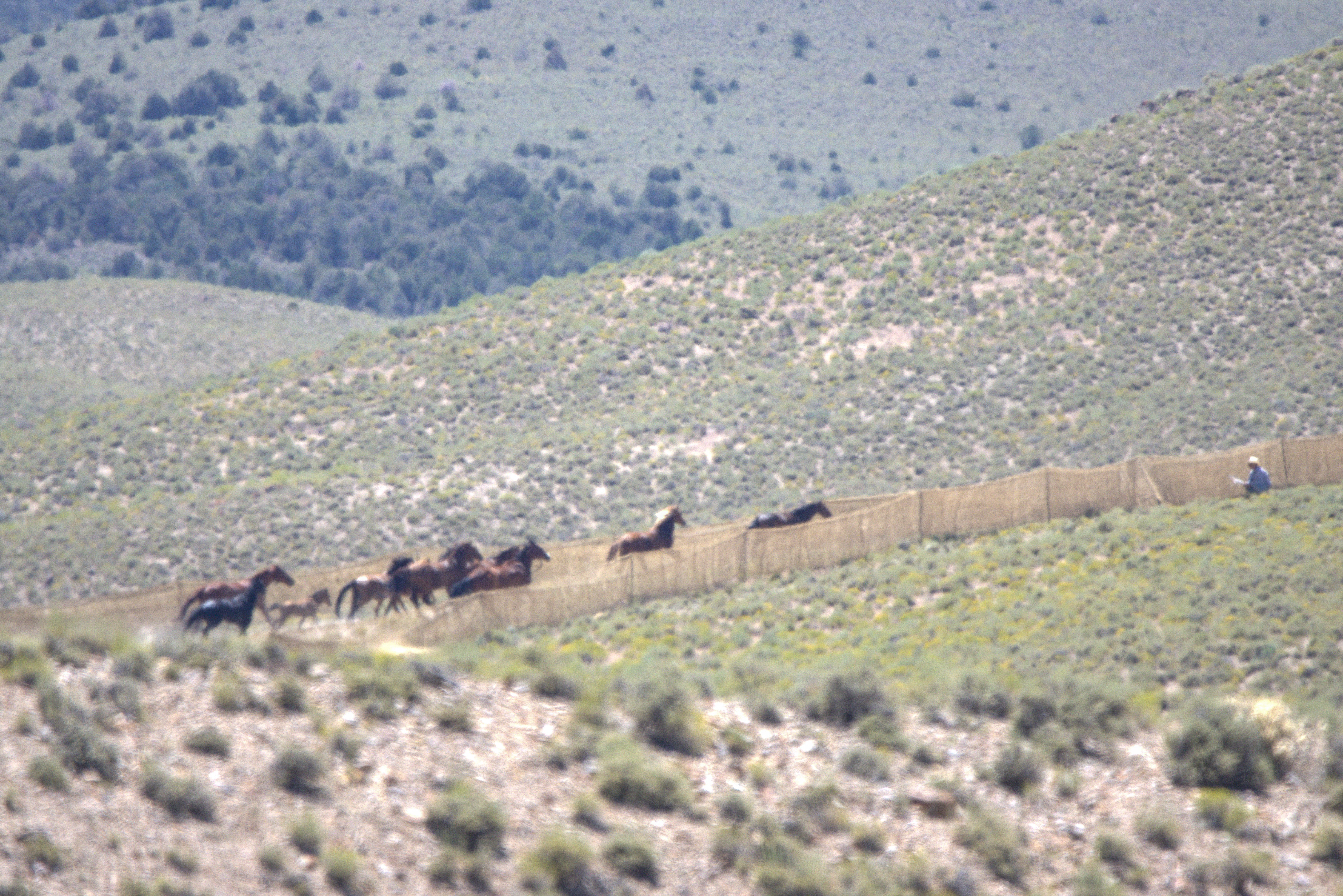

At 1:10 pm, the trap temperature was recorded as 88°F by the BLM. The horses appeared to have sweat glistening off their backs as they ran by. During one of the runs, a Palomino Stallion hit a catch pen panel while attempting to escape but continued into the single file loading area. Two other stallions managed to evade capture and passed the observation area. One stallion jumped the catch pen, while the other, along with a foal/younger horse, evaded the trap. The two older stallions were not pursued, and the young horse was guided back into the trap without being roped.
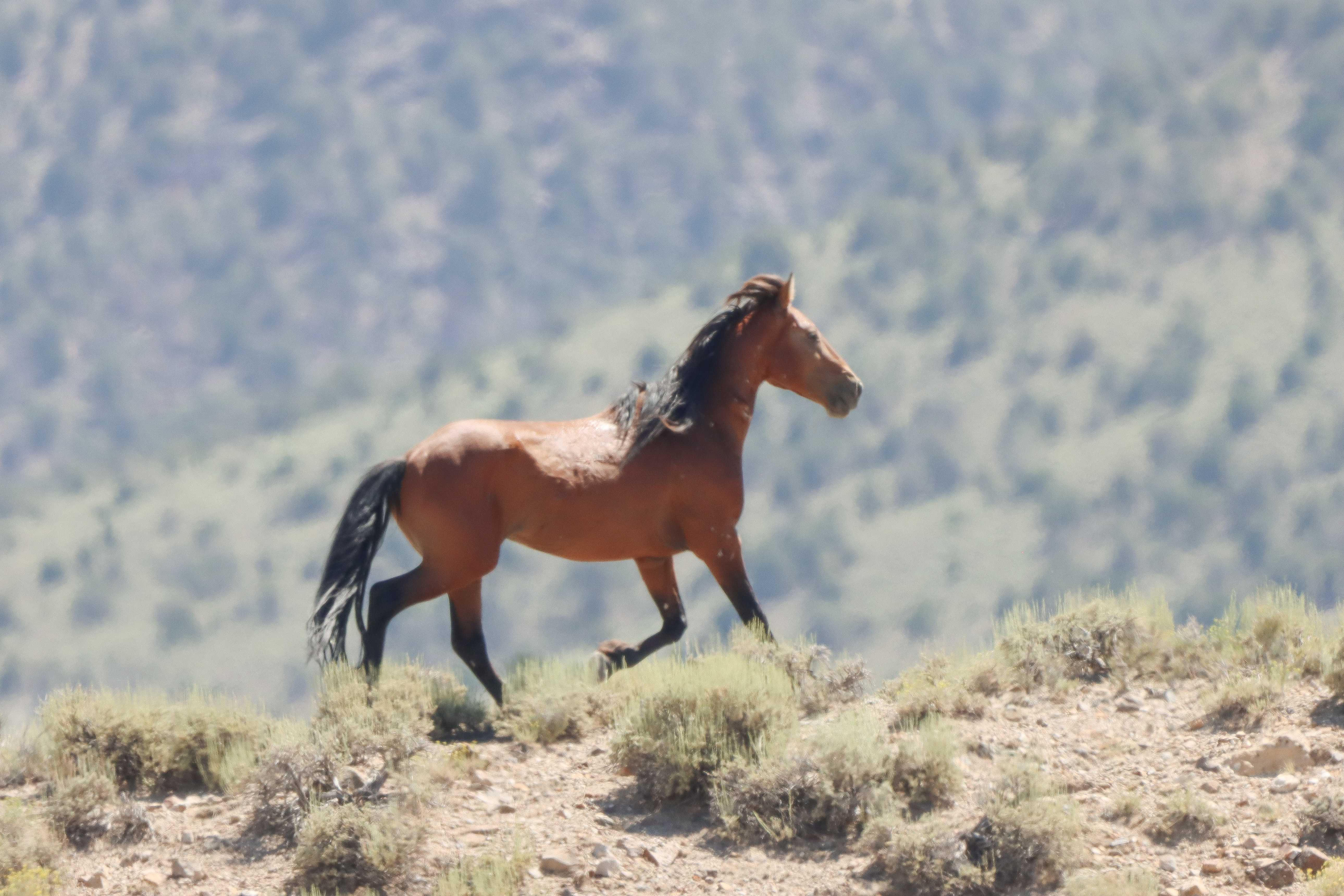

There was one death after a wild mare crashed into gate panel upon captured, breaking her neck.
66 Mustangs Captured, 1 Foal Dead at Thursday’s Roundup
July 13, 2023: We met with the BLM staff at 4:30 am at Shelbourne rest stop. We arrived at the observation location at 6:45 am, which was the same location as yesterday. This report documents the activities and observations made during the day.
At the observation location, we could hear a helicopter in the far-off distance, but it had not made any runs yet. BLM chose a spot slightly higher today, which allowed us to view more of the horses coming up the wing area. However, we still could not see the trap.
The first run occurred at 8:16 am, followed by the second run at 10:00 am. The horses were brought in directly in front of us. It was noted that the foals appeared to be struggling to keep up.
During the third run at 11:25 am, the wranglers with saddle horses went out. A foal was roped and taken directly to holding. The BLM staff confirmed that the foal had no injuries and clarified that it was not the same foal that died in holding*.
The fourth run took place at 12:30 pm. It was observed that the trap appeared to be very dry and dusty when the horses entered the catch pen. We were unable to determine from our location if the trap was being watered down. We contacted PR to inquire about watering the wing and catch pen area.
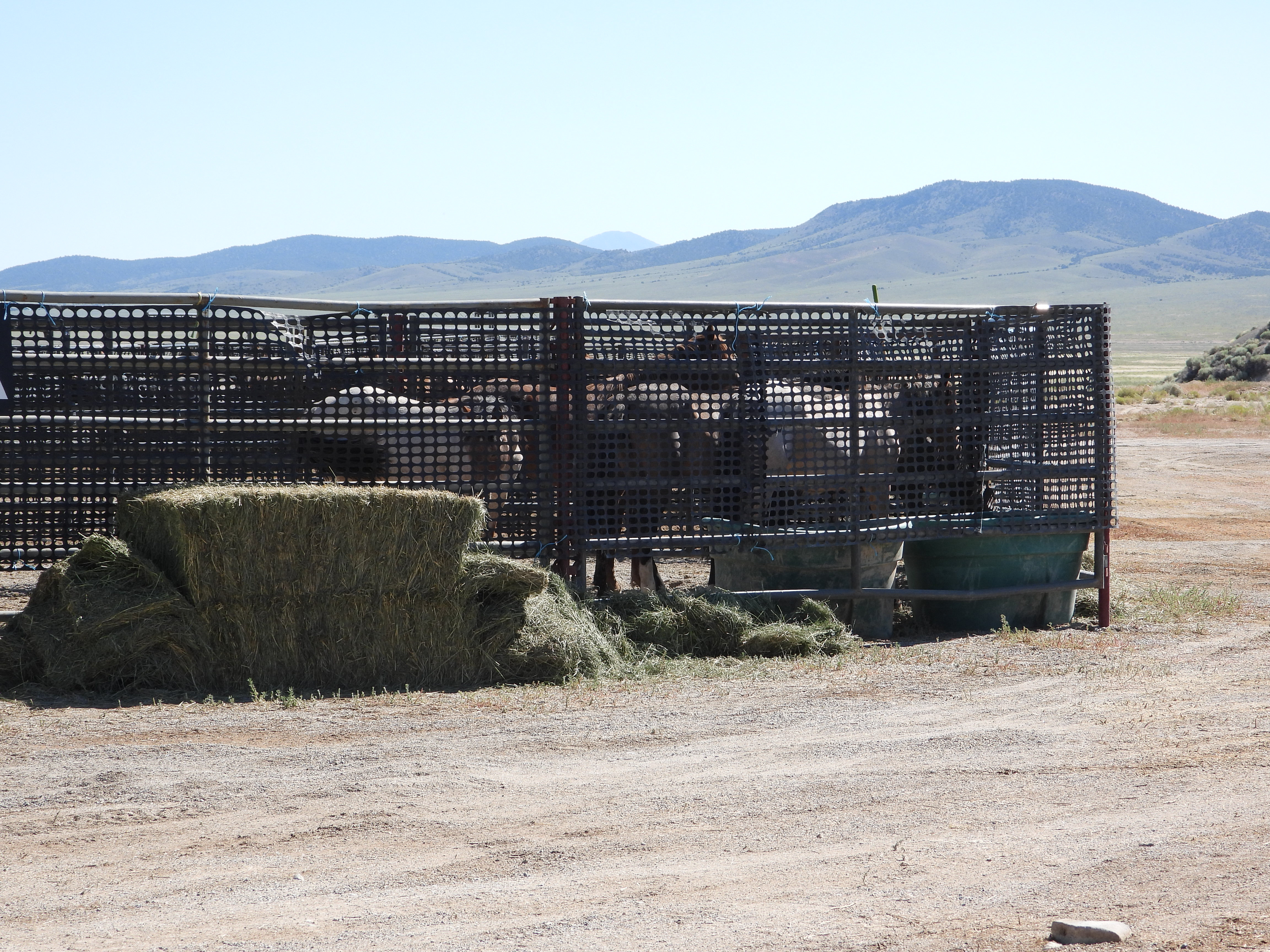



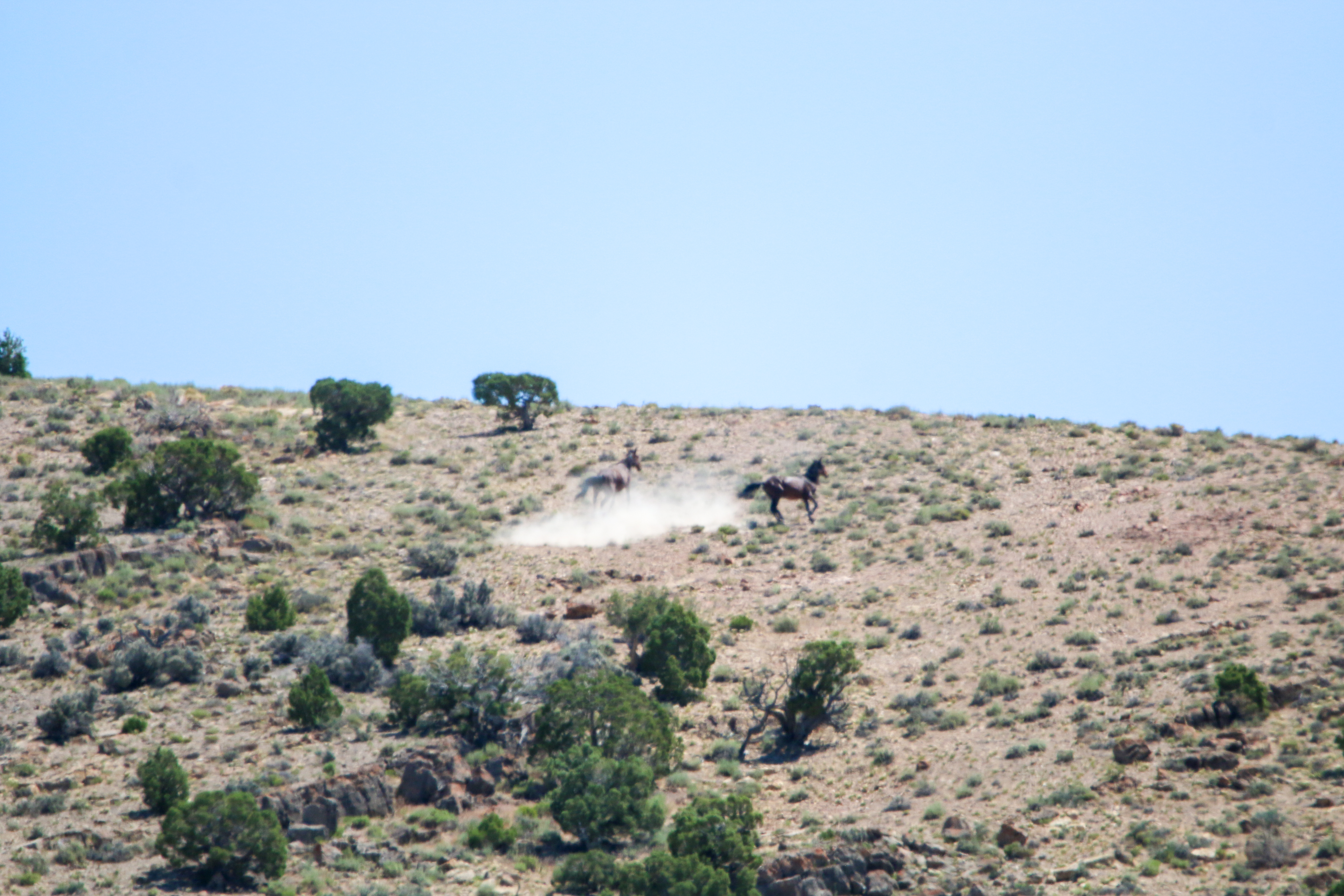


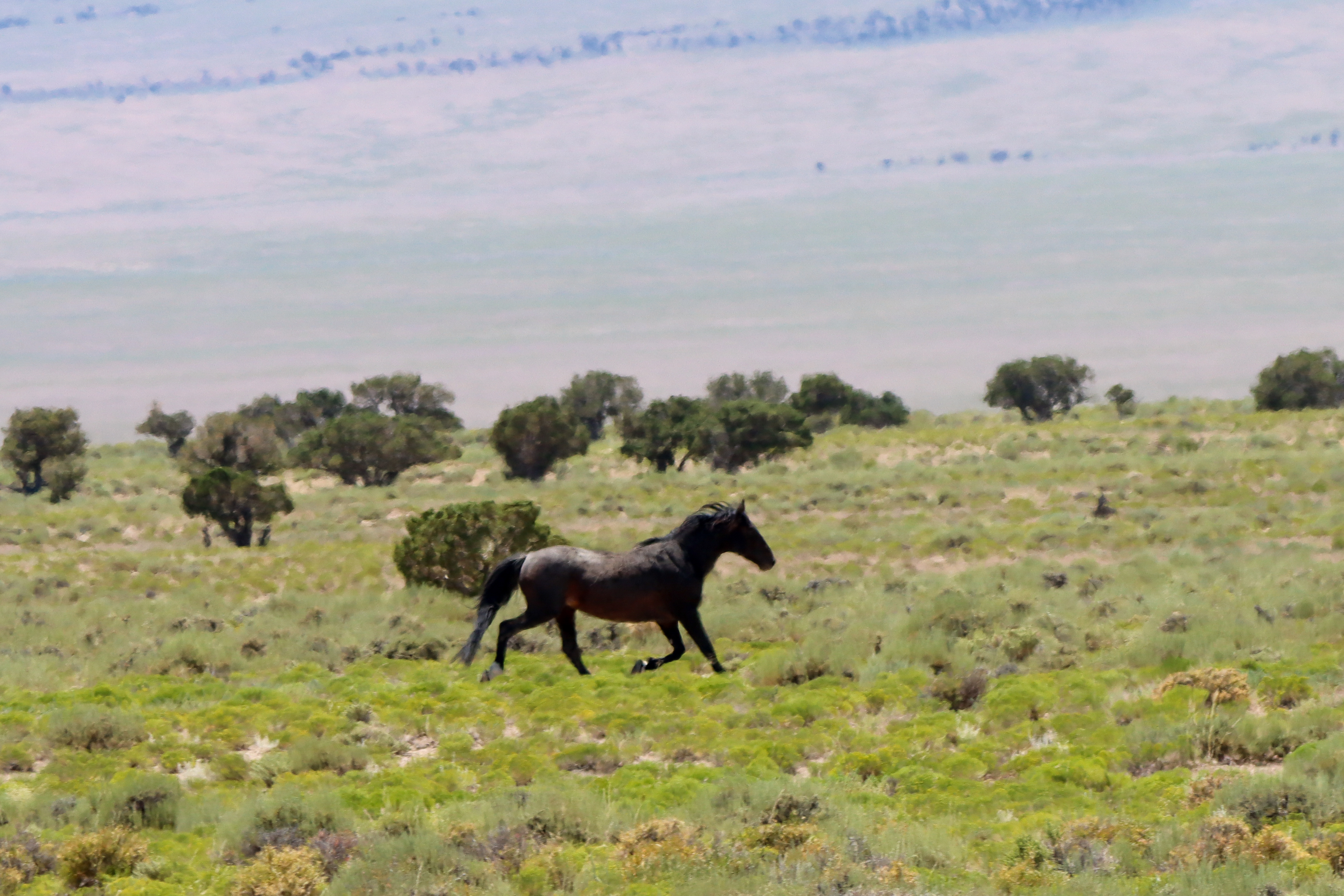
PR informed us that the water truck was on its way up but had to detour. They assured us that the trap would be watered shortly.
Note: Horses are more prone to developing respiratory issues when being run in the heat, rather than from breathing the dust created by the helicopter as they enter the catch pen.
The wild horse and burro specialist from the trap visited us to answer any questions. It was confirmed that most of the horses coming in today had better body scores.
Note: The low body scores observed in mares that came in the previous day were due to the harsh winter, pregnancy, and foaling. The fluctuation in wild horses' body weight is influenced by weather and seasonal factors, and it does not indicate an unhealthy state with little forage.
At 1:25 pm, a beautiful stallion ran by our observation point after jumping the panel at the trap.
We concluded our observations for the day at 1:46 pm, with the temperature at the trap area recorded as 91°F. In temporary holding, it was reported that one foal had died*. According to the BLM the foal died from dehydration "scours".
The temperatures throughout the day ranged from 52 to 93 degrees Fahrenheit, with sunny skies and a slight wind of 10-15 MPH.
55 mustangs lose freedom on Day 4 of operation
July 12, 2023: On Day 4 of the Antelope Complex-South Roundup, a total of 55 wild horses were captured. The weather conditions during the roundup ranged from 58 to 92 degrees Fahrenheit, with winds blowing at 10-15 miles per hour.
The team met with BLM staff at the Shelbourne rest area at 5:30 AM before proceeding to the new trap site.
The new trap site was located in the Tippett area, approximately 45 miles past Spring Creek. The trap used for capturing the horses was positioned approximately 3/4 of a mile away, making it impossible to have a direct view of the trap. The only visible area was the opening of the wing where the Judas horse is released. Due to the positioning of the trap and the presence of contractors' trucks for loading, it was not feasible to inspect the trap for compliance.
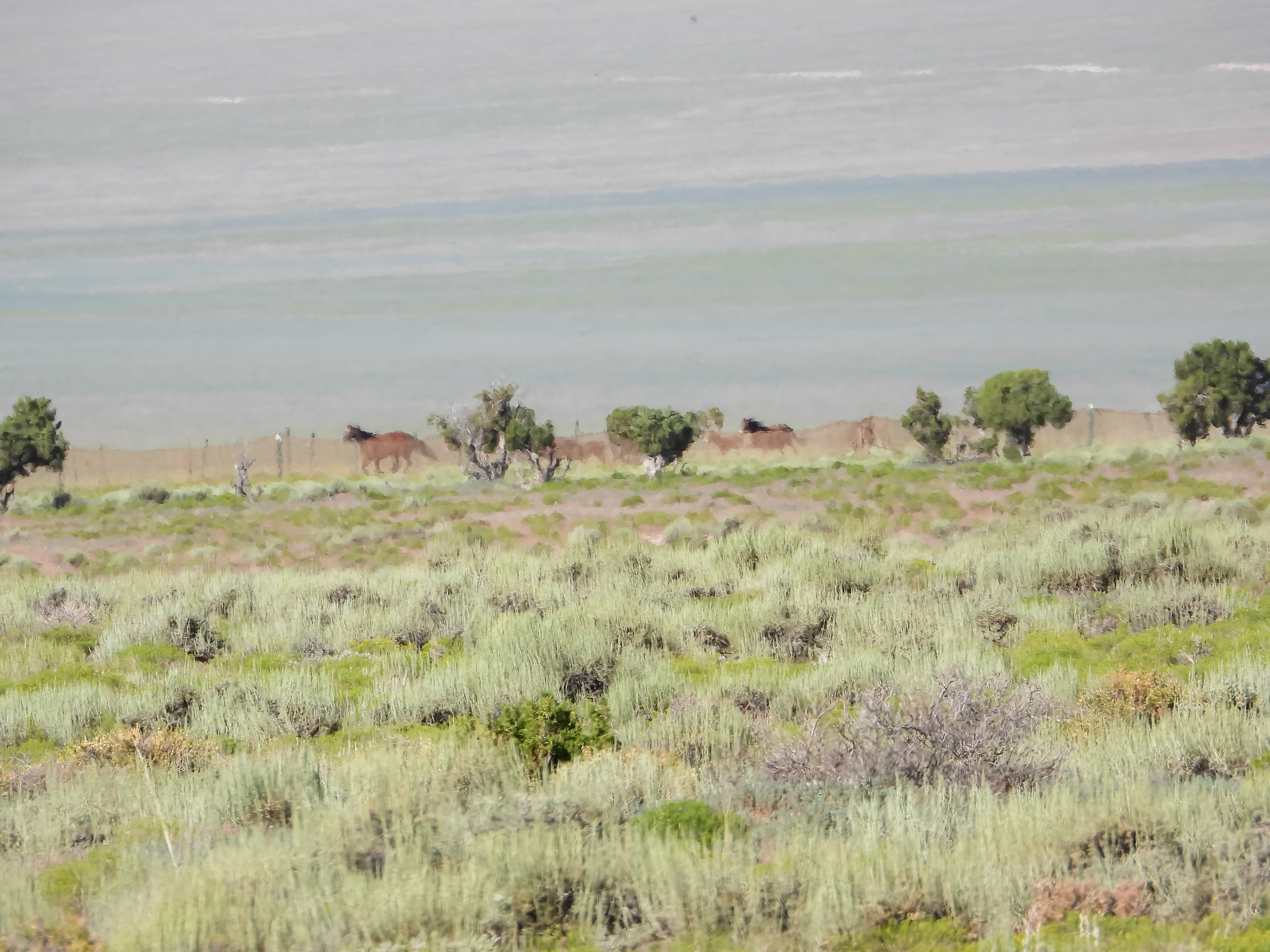
As an observer, it was frustrating not being able to ensure the humane treatment of the horses. There was only a brief window of about a minute to see the horses running up the wing, but it was not possible to assess their condition, such as whether they were sweating or the number of foals present. The runs of the horses occurred at various times throughout the day, with the last run taking place at 1:20 PM.

During the roundup, a wrangler and saddle horse went out to retrieve a foal but did not return with the foal. This raised concerns about the welfare of the foal. Additionally, the mares held temporarily at the new location had body scores ranging from 2 to 4, indicating varying levels of physical condition. Some mares showed a negative crease along their back, and a faint outline of ribs was discernible. However, the withers, shoulders, and neck were not obviously thin, and the hook bones were not discernible.

The limitations in viewing made it difficult to ensure proper oversight of the horses' treatment. It is important to address these concerns and ensure that the horses are treated humanely during the roundup.
Out of the 55 captured horses, there were 19 stallions, 22 mares, and 17 foals. These horses were then transported to holding.
Feds Capture 67 Mustangs on Day 3 of Antelope Complex-South Roundup, Foals Struggling
July 11, 2023: During one of the runs, it was noted that there were two foals in the band. The pilot initially ran them fast through the valley but slowed down as they approached. However, one of the foals had to be roped in and brought in eventually. The run took place at 6:15 am, and approximately seven runs were conducted throughout the day. The second run occurred at 6:40 am, and a foal that had been left behind had to be retrieved by a wrangler. Interestingly, the same sorrel stallion from the previous day managed to evade the trap again and ran in the same direction, disappearing behind a hill.
During the run around 11:00 am, two foals required assistance. A trailer was sent out to help retrieve a foal that was behind the hill, along with the one the wrangler had brought down.
In the run that came in at 2:30 pm, a foal lagged behind, causing the mare to turn around in the wing of the trap, seemingly searching for her baby. The dusty conditions and heat haze made it challenging to view the proceedings clearly.
It was observed that more foals than usual needed to be roped and brought in during this capture. The wrangler was responsible for retrieving the foals and displayed no unnecessary roughness while leading them in.
A tour of the temporary holding area was conducted, where the foals were seen adjusting and settling with their mothers. Unfortunately, due to the snow fencing around the panels, capturing decent photos at the holding area was not possible.
A veterinarian was present on-site, and the horses appeared to be adequately fed and watered, and though the stallions appeared flighty, no visible injuries were observed during the tour.
In conclusion, the BLM captured 67 mustangs, including 22 stallions, 28 mares, and 17 foals. At the time of this report, there were no deaths reported.
67 Mustangs Captured, 1 Foal Dead on Day 2 of Operation
July 10, 2023: The weather during the wild horse roundup operation was relatively mild, with temperatures ranging from 58 to 84 degrees Fahrenheit. There were slight winds at 10 to 15 mph, with a few gusts throughout the day.

Upon arrival at the site, the helicopter was already in the air, bringing in the first group of horses. In total, there were approximately 7 runs conducted throughout the day. At around 9:15 am, a veterinarian arrived at the trap area and appeared to be examining a foal from a distance.
During the operation, one stallion managed to jump the jute and ran up the hill, calling out to his family. This continued for about 15 to 20 minutes. As the rest of his family was being loaded into the livestock trailer, he continued to call out to them, and they responded in kind. He initially attempted to follow them but then turned back towards the trap area before disappearing behind the hill. After this incident, the operation concluded for the day.
A total of 75 horses were captured, including 25 stallions, 31 mares, and 19 foals. Out of these, 126 horses were shipped to the Palomino Valley Holding facility. This group consisted of 45 stallions, 58 mares, and 23 foals. Additionally, three foals were sent to foster care. One foal died due to colic during the operation.
Following the roundup, a tour of the temporary holding facility was provided. Most of the horses appeared calm, but some of the older stallions seemed slightly agitated. Witnessing the separation of horse families during the roundup can be emotionally exhausting and heartbreaking.
128 Wild Horses Captured in Day 1 of Antelope Complex-South Roundup, 4-Year-Old Mare Dies from Broken Neck
July 9, 2023: The meet time for the roundups was set at 4:30 am at the Schellbourne Rest Stop located 43 miles north of Ely, NV. From there, the group traveled north on Hwy 93 to the Kinsley Mine turnoff, which was approximately 30 miles away from the meet site. They then proceeded about 7 miles to the observation area.
Upon arrival, it was noted that a helicopter was already in the air, bringing in a run of horses. At the same time, two wranglers were seen roping a foal, leading it in seemingly without any harsh jerks or tight ropes. Following an explanation of where the horses would be coming in, our observer proceeded to set up their gear. By the time the setup was complete, the foal had already been brought in.
The observation area had a dead cow nearby, indicating the signs of a harsh winter. This raised questions about why a recount of the horses in the HMA was not conducted before the operation took place. The helicopter was seen bringing in horses at a good pace, with runs occurring approximately every 45 minutes to an hour. It was noted that the helicopter adhered to the rule of not running horses for more than ten miles.
One horse was observed to jump jute and call out to its family a few times while running. However, the helicopter did not pursue it. In total, 23 horses were captured during the observation period. From the observer's location, it appeared that the trap was set up in accordance with the Comprehensive Animal Welfare Program (CAWP). Additionally, a separate catch pen was set up to protect the foals from the larger horses.
None of the horses appeared to be in bad shape or showed any visible injuries. Most of them seemed to have a body score of 6 to 7, indicating good overall health. A veterinarian was present on-site.
Temporary holding areas were set up with two separate sections, one for the south side and another for the north side. The contractors' vehicles and trailers were in good working order, with trailers designed to accommodate the foals in the back area during transportation to the temporary holding facility. It should be noted that there was no fencing in the immediate area or near the trap.
Upon exiting the HMA, the observer witnessed wild horses still living free.


